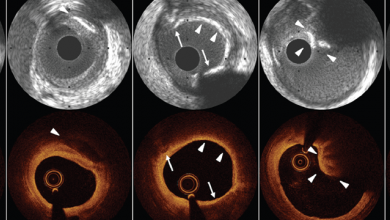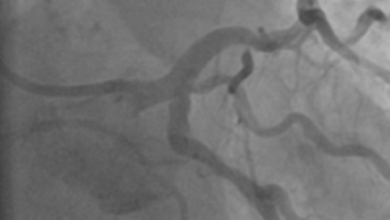Search results
Author(s):
Gérard Finet
,
Gilles Rioufol
Added:
3 years ago
“Nothing comes to us except falsified and altered by our senses.”
Michel de Montaigne (1533–1592)
Coronary angiography (CA) has been performed in cardiology centres for more than 50 years. The diagnosis it provides soon became the gold standard in coronaropathy. It is a purely anatomic diagnosis, and this approach has made a deep mark on cardiology, although the need for a prior non-invasive…
View more
Author(s):
Ferry van der Linde
Added:
3 years ago
Recently, a novel type of interventional device has become available on the market: the drug-eluting balloon (DEB). The established performance of the percutaneous transluminal coronary angioplasty (PTCA) balloon catheter has been combined with the proven efficacy of antiproliferative drugs.
The usefulness of DEBs has been established,1–6 especially for treating in-stent restenosis (ISR), when…
View more
Dedicated Bifurcation Drug-eluting Stent BiOSS® – A Novel Device for Coronary Bifurcation Treatment
Author(s):
Robert Gil
,
Dobrin Vassilev
,
Jacek Bil
Added:
3 years ago
Article
Author(s):
Giuseppe Sangiorgi
,
Fabrizio Clementi
,
Clarissa Cola
Added:
3 years ago
Several independent lines of clinical evidence have shown that critical stenoses cause only a fraction of ACS. Rather, ruptures of a thin fibrous cap covering a large lipid-rich necrotic or superficial intimal erosion frequently trigger acute coronary thromboses at sites of non-critical narrowing of coronary arteries. This shift in thinking has fostered the notion of the so-called 'vulnerable' or…
View more
Author(s):
Niels Ramsing Holm
,
Evald Høj Christiansen
Added:
3 years ago
Optimal treatment of left main coronary artery (LMCA) lesions requires a highly tailored approach that incorporates patient comorbidities, clinical presentation, the extent of coronary artery disease (CAD), lesion characteristics and local expertise.1,2 Coronary artery bypass grafting (CABG) is the treatment for LMCA lesions that has the highest evidence level in guideline recommendations.2,3…
View more
Author(s):
J Ribamar Costa Jr
,
Alexandre Abizaid
Added:
3 years ago
Coronary stenting is a percutaneous procedure intended to regain coronary artery patency overcoming the major limitations of balloon angioplasty: acute recoil and negative vessel remodelling.1–3 The first contemporary balloon-expandable stent was the Palmaz, immediately followed by an articulated variant known as the Palmaz-Schatz, the first stent to be tested in large multicentre trials (the…
View more
Author(s):
Mattia Cattaneo
,
Alberto Froio
,
Augusto Gallino
Added:
3 years ago
Imaging has played an instrumental role in the diagnostic and prognostic assessment of cardiovascular diseases. Arterial Doppler ultrasound, echocardiography, myocardial perfusion imaging tests and angiography are now part of everyday clinical practice and represent a cornerstone of atherosclerosis management.1 During the past two decades, there has been an expansion of the available imaging…
View more
Author(s):
Kensuke Nishimiya
,
Yasuharu Matsumoto
,
Hiroaki Shimokawa
Added:
3 years ago
Vasa Vasorum
The coronary arterial wall generally consists of the tunica intima, tunica media and tunica adventitia. In particular, the coronary adventitia harbours the vasa vasorum (VV),which has a diameter of 50–300 μm and plays an important role as a network of nutrient blood vessels to the arterial wall (Figure 1).1–3
The VV is enhanced in association with arterial wall thickening when the…
View more
Author(s):
Yasushi Ueki
,
Tatsuhiko Otsuka
,
Kiyoshi Hibi
,
et al
Added:
3 years ago
Heavily calcified coronary artery lesions hinder device delivery and limit stent expansion, which is the most relevant predictor of stent failure. This may result in low procedural success and poor clinical outcomes. Coronary angiography has a limited ability to detect calcifications when planning an optimal percutaneous coronary intervention (PCI) strategy. Intracoronary imaging can provide…
View more
Author(s):
Krzysztof Pujdak
,
Jan Kähler
,
Marc Werner
Added:
3 years ago
Significant stenosis of the left main (LM) coronary artery is observed in 7% of coronary angiographies.1 Coronary artery bypass grafting has traditionally been the treatment of choice. In recent years, percutaneous coronary intervention (PCI) has evolved as an alternative, especially for low and intermediate SYNTAX score patients.2 However, during PCI of bifurcation lesions, approximately 50% of…
View more









 « First
« First